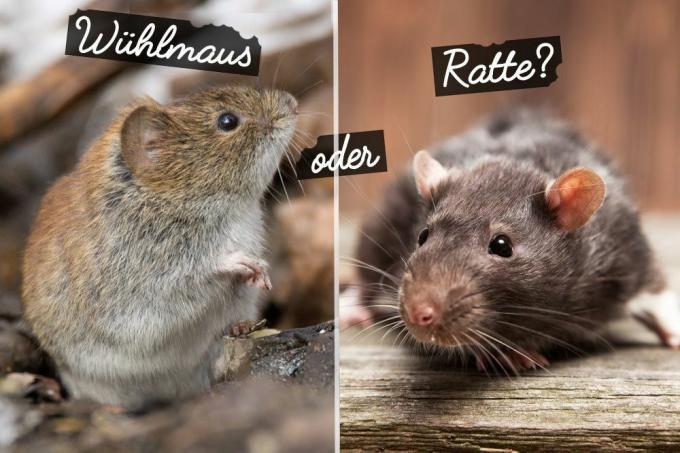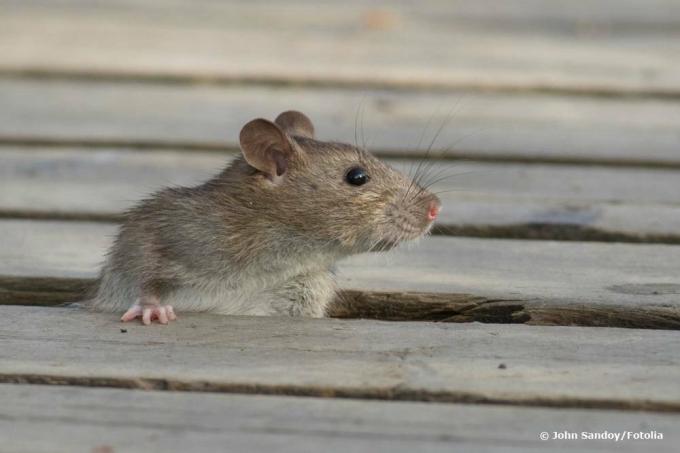
table of contents
- Vole or rat?
- Voles
- Rats
- attention
Neither a vole nor a rat are welcome guests in our gardens. No wonder: Both can cause considerable damage there, and rats also have a certain disgust factor. In order to get rid of them, one must first of all recognize which rodent it is exactly. It is best to orientate yourself on their traces and legacies. You will usually not get to see the nocturnal animals.
Vole or rat?
There are a number of animals to be happy about their presence in the garden. This includes birds and hedgehogs, but also earthworms. The absolutely undesirable animal guests, however, include voles and rats. Although they do not pose a direct threat to humans, their natural behavior can lead to significant problems. One of the peculiarities of both rodents is that they dig their way through the garden with a certain preference. Voles create an extensive network of tunnels and caves. In doing so, they keep throwing up mounds of earth. This urge is far less pronounced in rats. However, they undercut stone slabs with great persistence in order to be able to retreat into the caves created by them.
Note: Voles in the garden may be fought, a mole however, it is under nature protection and may not even be distributed. The rodents can be easily distinguished by their mounds: in voles they are rather small and flat, in moles they are large and round to spherical.
In order to be able to combat voles and rats effectively, it must first be determined which rodent species it is. The easiest way to do this is to carefully examine the legacies, traces and changes in the garden. Most of the time, you will hardly ever get to see the animals themselves. Differences can usually be found by taking a closer look at the garden.
Voles
The following abnormalities are typical for voles:
Mound of earth
Mounds of earth indicate that voles have spread in the garden. Rats dig too, but they don't raise mounds in the process.
Corridors
Voles tend to create an extensive system of tunnels in the ground. However, they dig relatively close to the surface. If you break into a corridor close to the surface while walking, this also indicates a corresponding infestation. Rats, on the other hand, do not create such corridors.
Plant damage
In contrast to the rat and, by the way, also to the mole, a vole is a pure herbivore. If you discover eaten plants in the garden area and especially in the beds, this is a clear indication of an infestation with voles. You get certainty at the latest when the roots have been eaten by plants.
Rats
The following abnormalities are again typical for rats:
Undercutting
If you suddenly find undercutting in slabs or garden paths, there is a high probability that a rat was at work underneath. A vole, on the other hand, is more likely to avoid paths.
Note: The undercutting serves as a place of retreat for the rat during the day. It is always open on one side to enable it to escape as quickly as possible in the event of danger.
Rat droppings
Rats don't have a special place to relieve themselves. They therefore distribute their excrement over the entire area - both underground and above ground. So if you discover rat droppings, you can safely assume that at least one of the animals lives here. Rat excrement has a more spindle-shaped shape, reminiscent of a grain of rice, but is much larger with a length of around two centimeters. Fresh manure has a black sheen. Older manure, on the other hand, looks dried out and quickly becomes crumbly.

Gnaw damage
Rats are omnivores. You hardly disdain possible feed. Rats can therefore often be recognized very easily by the gnaw damage they caused. The young shoots on the trees are not excluded. The animals are excellent climbers who get over the trunk of the tree into the branches and enjoy themselves there. So gnawing traces in trees is a pretty sure indication of a rat infestation. Voles would never, ever do that. A vole hardly tends to climb anyway.
Walkways
If rats move around in the garden, they will always use the same paths whenever possible. These routes can be seen relatively easily over time. They appear as relatively narrow strips on which the dirt has largely trodden. Often you can also see the traces of the animals in it.
Compost infestation
If you have compost on your property, you will quickly find out in the event of a rat infestation that chaos will soon reign there. The animals rummage through the compost with a certain predilection in search of food. They are primarily looking for animal food such as worms. However, they do not disdain any leftover food from us humans. A vole doesn't even begin to care.
attention
The differences between the vole and the rat should have become clear. The traces of both rodents should normally be able to be detected relatively clearly. It is simply important to have a careful view of the garden. As soon as changes become noticeable there, you should definitely keep an eye on the matter. A single mound in the race Incidentally, does not necessarily mean that voles have settled on the site. Several hills, however, are a clear indication. Even if the compost has been rummaged through by a rat, it is still possible that the rat lives elsewhere. For both rodents, the following applies: If several tracks appear at the same time and, above all, in heap, one can assume that uninvited guests have spread. Rats in particular can reproduce explosively and in a very short time. If there are frequent rat tracks, it is strongly recommended to call an exterminator who will take a closer look at the problem.





